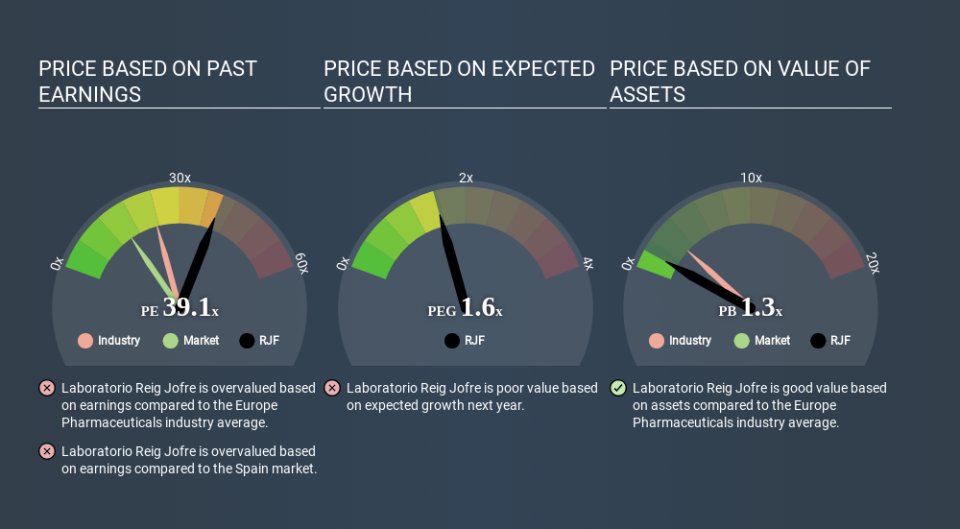How Does Laboratorio Reig Jofre's (BME:RJF) P/E Compare To Its Industry, After Its Big Share Price Gain?

The Laboratorio Reig Jofre (BME:RJF) share price has done well in the last month, posting a gain of 33%. And the full year gain of 28% isn't too shabby, either!
Assuming no other changes, a sharply higher share price makes a stock less attractive to potential buyers. In the long term, share prices tend to follow earnings per share, but in the short term prices bounce around in response to short term factors (which are not always obvious). The implication here is that deep value investors might steer clear when expectations of a company are too high. One way to gauge market expectations of a stock is to look at its Price to Earnings Ratio (PE Ratio). A high P/E ratio means that investors have a high expectation about future growth, while a low P/E ratio means they have low expectations about future growth.
View our latest analysis for Laboratorio Reig Jofre
Does Laboratorio Reig Jofre Have A Relatively High Or Low P/E For Its Industry?
Laboratorio Reig Jofre's P/E of 39.15 indicates some degree of optimism towards the stock. The image below shows that Laboratorio Reig Jofre has a higher P/E than the average (23.4) P/E for companies in the pharmaceuticals industry.
That means that the market expects Laboratorio Reig Jofre will outperform other companies in its industry. The market is optimistic about the future, but that doesn't guarantee future growth. So investors should delve deeper. I like to check if company insiders have been buying or selling.
How Growth Rates Impact P/E Ratios
Probably the most important factor in determining what P/E a company trades on is the earnings growth. If earnings are growing quickly, then the 'E' in the equation will increase faster than it would otherwise. That means even if the current P/E is high, it will reduce over time if the share price stays flat. And as that P/E ratio drops, the company will look cheap, unless its share price increases.
Laboratorio Reig Jofre shrunk earnings per share by 46% over the last year. And EPS is down 35% a year, over the last 5 years. This growth rate might warrant a below average P/E ratio.
Remember: P/E Ratios Don't Consider The Balance Sheet
The 'Price' in P/E reflects the market capitalization of the company. That means it doesn't take debt or cash into account. In theory, a company can lower its future P/E ratio by using cash or debt to invest in growth.
While growth expenditure doesn't always pay off, the point is that it is a good option to have; but one that the P/E ratio ignores.
Is Debt Impacting Laboratorio Reig Jofre's P/E?
Net debt totals just 8.5% of Laboratorio Reig Jofre's market cap. It would probably trade on a higher P/E ratio if it had a lot of cash, but I doubt it is having a big impact.
The Verdict On Laboratorio Reig Jofre's P/E Ratio
Laboratorio Reig Jofre's P/E is 39.1 which is above average (15.3) in its market. With some debt but no EPS growth last year, the market has high expectations of future profits. What we know for sure is that investors have become much more excited about Laboratorio Reig Jofre recently, since they have pushed its P/E ratio from 29.5 to 39.1 over the last month. For those who prefer to invest with the flow of momentum, that might mean it's time to put the stock on a watchlist, or research it. But the contrarian may see it as a missed opportunity.
When the market is wrong about a stock, it gives savvy investors an opportunity. As value investor Benjamin Graham famously said, 'In the short run, the market is a voting machine but in the long run, it is a weighing machine. So this free report on the analyst consensus forecasts could help you make a master move on this stock.
Of course, you might find a fantastic investment by looking at a few good candidates. So take a peek at this free list of companies with modest (or no) debt, trading on a P/E below 20.
Love or hate this article? Concerned about the content? Get in touch with us directly. Alternatively, email editorial-team@simplywallst.com.
This article by Simply Wall St is general in nature. It does not constitute a recommendation to buy or sell any stock, and does not take account of your objectives, or your financial situation. We aim to bring you long-term focused analysis driven by fundamental data. Note that our analysis may not factor in the latest price-sensitive company announcements or qualitative material. Simply Wall St has no position in any stocks mentioned. Thank you for reading.



